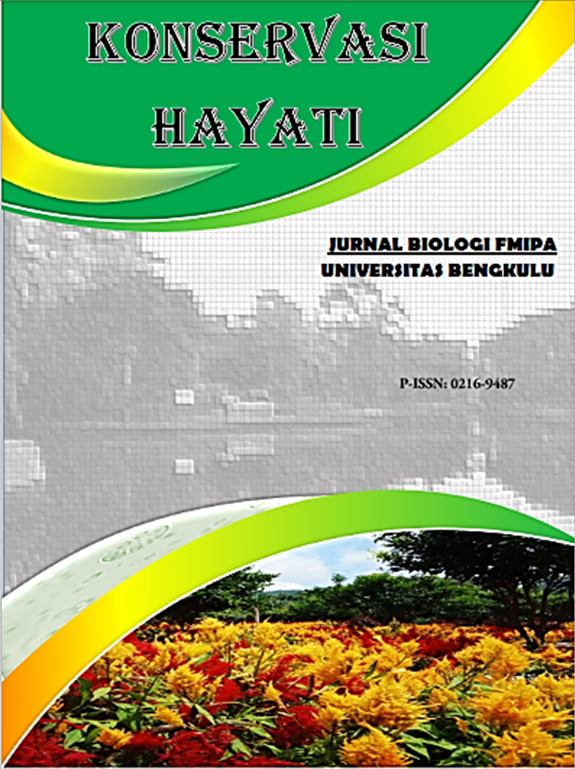Main Article Content
Abstract
This study aims to determine the response given by the red lettuce plant to the provision of nutrients in the form of nutrient solution (AB Mix) on the horizontal installation of the hydroponic system. The study was conducted on December 20, 2017 until February 16, 2018 at the PKK Gardens Education Center in Bengkulu province. Seeding process of Red Lettuce Seedlings is carried out for 14 days then transferred to a net pot at the installation in the Greenhouse. Fertilizers with the Fiora A and B Brands are dissolved to be mixed in a nutrient bath with a capacity of 3000 L with a nutrient density of 500 ppm in the Greenhouse to be distributed to the horizontal installation of the hydroponic system inside the Greenhouse. Then growth observations were carried out on 10 plant samples with parameters of leaf length, leaf width, number of leaves, stem height, and
stem diameter for 30 days. The results obtained by sample 1-10 have an average growth and development that is not much different. The maximum leaf length and leaf width parameters are in samples 2 and 3. While the highest number of leaf strands in sample 3 is 22 strands with an average of 18 strands and sample 4 has the highest stem height parameter of 3.5 cm with an average height 2.7 cm. The largest stem diameter in sample 4 is 4.1 cm with an average of 3.38 cm. The response of red lettuce after the last week showed symptoms of leaves that are less red with relatively more withered body.
Keywords
Article Details
Authors who publish in this journal agree with the following terms:
- Authors retain copyright and grant the journal right of first publication with the work simultaneously licensed under a Creative Commons Attribution-ShareAlike 4.0 International License that allows others to share the work with an acknowledgement of the work's authorship and initial publication in this journal.
- Authors are able to enter into separate, additional contractual arrangements for the non-exclusive distribution of the journal's published version of the work (e.g., post it to an institutional repository or publish it in a book), with an acknowledgement of its initial publication in this journal.
- Authors are permitted and encouraged to post their work online (e.g., in institutional repositories or on their website) prior to and during the submission process, as it can lead to productive exchanges, as well as earlier and greater citation of published work (See The Effect of Open Access).
- This work is licensed under a Creative Commons Attribution-ShareAlike 4.0 International License.
References
- Adam CR., dkk. 1995. Principle of Horticulture. Butterworth Heinemang. London. 278 p.
- Falah. 2006. Produksi Tanaman dan Makanan dengan menggunakan Hidroponik. (http://inovasi-online.co.id/products/agli/hiryo.html). Diakses 10 Februari 2018.
- Istiqomah, S. 2006. Menanam Hidroponik. Jakarta: Azka Press.
- Jensen, M. H. 1997. Hydroponics. J. Hort. Sci. 32 (6): 1018-1021.
- Karsono, S. 2013. Exploring Classroom Hydroponics. Bogor: Parung Farm.
- Lakitan. 2012. Dasar-Dasar Fisiologi Tumbuhan. Jakarta: Raja Grafindo Persada.
- Lingga, P, 2005. Petunjuk Penggunaan Pupuk. Jakarta: Penebar Swadaya.
- Nazaruddin., 2003. Budidaya dan Pengaturan Panen Sayuran
- Dataran Rendah. Jakarta: Penebar Swadaya.
- Prihmantoro, H dan Indriani, H. Y. 2002. Hidroponik Sayuran
- Semusim untuk Bisnis dan Hobi. Jakarta: Penebar Swadaya.
- Purbarani, D.A. 2011. Kajian Frekuensi dan Tinggi Penggenangan Larutan Nutrisi pada Budidaya Baby Kailan (Brassica oleraceae var alboglabra) dengan Hidroponik EBB and Flow. Surakarta: Universitas Sebelas Maret.
- Resh, HM. 1998. Hydroponic Food Production. Woodbridge Press
- Publ. Co. Santa Barbara. 527p.
- Suwandi. 2009. Menakar kebutuhan hara tanaman dalam pengembangan inovasi budidaya sayuran berkelanjutan. Pengembangan Inovasi Pertanian 2(2):131- 147. [www.pustaka.litbang.deptan.go.id/ publikasi/ip022094.pdf 25 Februari 2018].
- Tony, H. 2002. Berkebun Hidroponik Secara Murah. Jakarta: Penebar Swadaya.
References
Adam CR., dkk. 1995. Principle of Horticulture. Butterworth Heinemang. London. 278 p.
Falah. 2006. Produksi Tanaman dan Makanan dengan menggunakan Hidroponik. (http://inovasi-online.co.id/products/agli/hiryo.html). Diakses 10 Februari 2018.
Istiqomah, S. 2006. Menanam Hidroponik. Jakarta: Azka Press.
Jensen, M. H. 1997. Hydroponics. J. Hort. Sci. 32 (6): 1018-1021.
Karsono, S. 2013. Exploring Classroom Hydroponics. Bogor: Parung Farm.
Lakitan. 2012. Dasar-Dasar Fisiologi Tumbuhan. Jakarta: Raja Grafindo Persada.
Lingga, P, 2005. Petunjuk Penggunaan Pupuk. Jakarta: Penebar Swadaya.
Nazaruddin., 2003. Budidaya dan Pengaturan Panen Sayuran
Dataran Rendah. Jakarta: Penebar Swadaya.
Prihmantoro, H dan Indriani, H. Y. 2002. Hidroponik Sayuran
Semusim untuk Bisnis dan Hobi. Jakarta: Penebar Swadaya.
Purbarani, D.A. 2011. Kajian Frekuensi dan Tinggi Penggenangan Larutan Nutrisi pada Budidaya Baby Kailan (Brassica oleraceae var alboglabra) dengan Hidroponik EBB and Flow. Surakarta: Universitas Sebelas Maret.
Resh, HM. 1998. Hydroponic Food Production. Woodbridge Press
Publ. Co. Santa Barbara. 527p.
Suwandi. 2009. Menakar kebutuhan hara tanaman dalam pengembangan inovasi budidaya sayuran berkelanjutan. Pengembangan Inovasi Pertanian 2(2):131- 147. [www.pustaka.litbang.deptan.go.id/ publikasi/ip022094.pdf 25 Februari 2018].
Tony, H. 2002. Berkebun Hidroponik Secara Murah. Jakarta: Penebar Swadaya.
